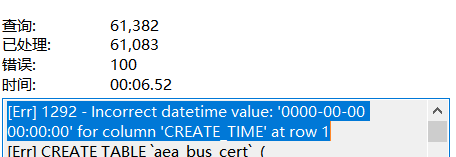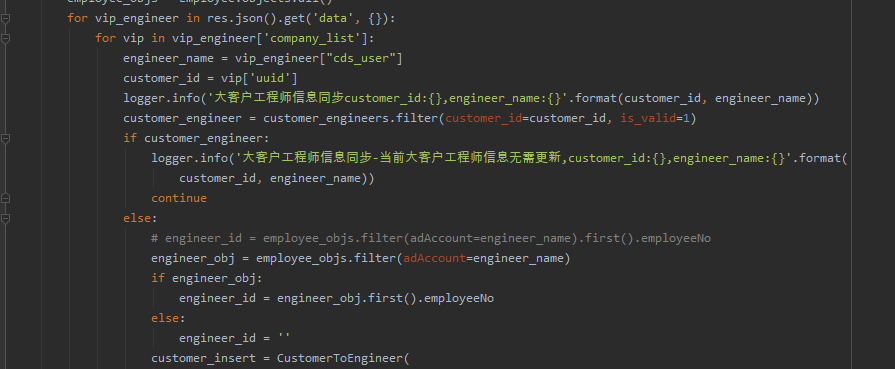前言介绍
附录:Spring源码学习专栏
在上一章节的学习中,我们对Springframework的AOP基本概念和用法有了基本的了解熟悉,接着本文继续学习Springframework核心技术点AOP技术的源码
1、实验环境准备
实验环境:
- SpringFramework版本
- Springframework5.0.x
- 开发环境
- JAR管理:gradle 4.9/ Maven3.+
- 开发IDE:IntelliJ IDEA 2018.2.5
- JDK:jdk1.8.0_31
- Git Server:Git fro window 2.8.3
- Git Client:SmartGit18.1.5(可选)
2、Spring AOP代理
在上一章的学习,我们知道了Spring AOP是AOP的实现方案之一,这种方案有别于AspectJ,这是一种将Spring IOC技术和Aop进行结合的技术,在Spring2.0+引用了AspectJ的jar,并进行自己的实现,这是一种基于代理的技术,具体来说是基于JDK动态代理和CBLIB动态代理的技术
为什么说Spring AOP实现基于IOC?首先挑出一个比较重要的Spring AOP自动创建代理类:DefaultAdvisorAutoProxyCreator
在IDEA中生成一张DefaultAdvisorAutoProxyCreator的类图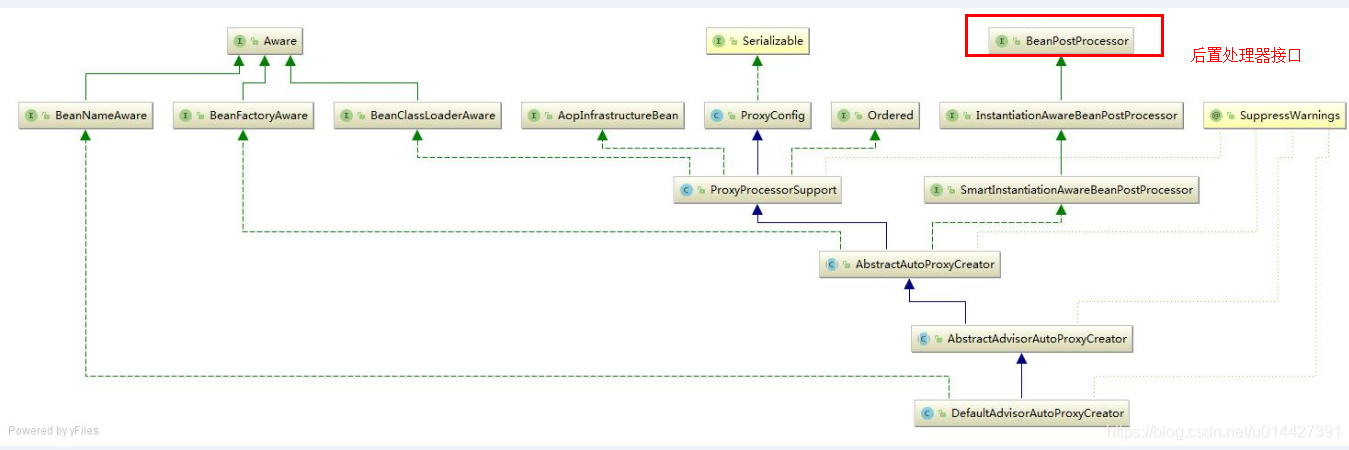
从图可以看出DefaultAdvisorAutoProxyCreator实现了后置处理器的接口,也就是说DefaultAdvisorAutoProxyCreator是一个后置处理器
3、使用调试代码
所以,本文要写个DefaultAdvisorAutoProxyCreator例子进行学习,学习源码,建议通过debug进行学习
User.java:
package com.example.aop.bean;
public class User {
private String username;
private String password;
public String getUsername() {
return username;
}
public void setUsername(String username) {
this.username = username;
}
public String getPassword() {
return password;
}
public void setPassword(String password) {
this.password = password;
}
@Override
public String toString() {
return "User{" +
"username='" + username + '\'' +
", password='" + password + '\'' +
'}';
}
}
UserService.java:
package com.example.aop.service;
import com.example.aop.bean.User;
/**
* <pre>
* UserService
* </pre>
*
* <pre>
* @author mazq
* 修改记录
* 修改后版本: 修改人: 修改日期: 2020/11/20 18:02 修改内容:
* </pre>
*/
public interface UserService {
User addUser(User user);
User getUser();
String findUserNameById(Long id);
}
UserServiceImpl.java:
package com.example.aop.service.impl;
import com.example.aop.bean.User;
import com.example.aop.service.UserService;
import org.springframework.beans.BeanUtils;
import org.springframework.stereotype.Service;
/**
* <pre>
* UserServiceImpl
* </pre>
*
* <pre>
* @author mazq
* 修改记录
* 修改后版本: 修改人: 修改日期: 2020/11/20 17:57 修改内容:
* </pre>
*/
@Service
public class UserServiceImpl implements UserService {
private static User user = null;
@Override
public User addUser(User userDto) {
user = new User();
BeanUtils.copyProperties(userDto,user);
return user;
}
@Override
public User getUser() {
return user;
}
@Override
public String findUserNameById(Long id) {
return "tom";
}
}
MethodInterceptor,是一个拦截方法的MethodInterceptor
package com.example.aop.core.interceptor;
import org.aopalliance.intercept.MethodInterceptor;
import org.aopalliance.intercept.MethodInvocation;
/**
* <pre>
* TestMethodInterceptor
* </pre>
*
* <pre>
* @author mazq
* 修改记录
* 修改后版本: 修改人: 修改日期: 2020/11/23 10:28 修改内容:
* </pre>
*/
public class TestMethodInterceptor implements MethodInterceptor {
@Override
public Object invoke(MethodInvocation methodInvocation) throws Throwable {
System.out.println(String.format("方法调用前(before method invoke) :%s",methodInvocation));
Object implObj = methodInvocation.proceed();
System.out.println(String.format("方法调用后(after method invoke) :%s",implObj));
return implObj;
}
}
配置类,拦截get开头的方法:
package com.example.aop.config;
import com.example.aop.core.interceptor.TestMethodInterceptor;
import com.example.aop.service.UserService;
import com.example.aop.service.impl.UserServiceImpl;
import org.aopalliance.aop.Advice;
import org.springframework.aop.framework.autoproxy.DefaultAdvisorAutoProxyCreator;
import org.springframework.aop.support.NameMatchMethodPointcutAdvisor;
import org.springframework.context.annotation.Bean;
import org.springframework.context.annotation.Configuration;
/**
* <pre>
* SpringAutoProxyConfiguration
* </pre>
*
* <pre>
* @author mazq
* 修改记录
* 修改后版本: 修改人: 修改日期: 2020/11/26 14:57 修改内容:
* </pre>
*/
@Configuration
public class SpringAutoProxyConfiguration {
@Bean
public UserService userService() {
return new UserServiceImpl();
}
@Bean
public Advice methodInterceptor() {
return new TestMethodInterceptor();
}
@Bean
public NameMatchMethodPointcutAdvisor nameMatchMethodPointcutAdvisor() {
NameMatchMethodPointcutAdvisor nameMatchMethodPointcutAdvisor = new NameMatchMethodPointcutAdvisor();
nameMatchMethodPointcutAdvisor.setMappedName("get*");
nameMatchMethodPointcutAdvisor.setAdvice(methodInterceptor());
return nameMatchMethodPointcutAdvisor;
}
@Bean
public DefaultAdvisorAutoProxyCreator defaultAdvisorAutoProxyCreator() {
return new DefaultAdvisorAutoProxyCreator();
}
}
测试类:TestApplication
package com.example;
import com.example.aop.config.SpringAspectJConfiguration;
import com.example.aop.service.UserService;
import com.example.config.AppConfiguration;
import org.springframework.context.annotation.AnnotationConfigApplicationContext;
/**
* <pre>
* TestController
* </pre>
*
* <pre>
* @author mazq
* 修改记录
* 修改后版本: 修改人: 修改日期: 2020/11/05 10:22 修改内容:
* </pre>
*/
public class TestApplication {
public static void testSpringAopProxy() {
AnnotationConfigApplicationContext context = new AnnotationConfigApplicationContext();
context.register(SpringAutoProxyConfiguration.class);
context.refresh();
//ClassPathXmlApplicationContext context = new ClassPathXmlApplicationContext("classpath:spring_defaultAdvisorAutoProxyCreator_config.xml");
UserService userService = context.getBean(UserService.class);
User userDto = new User();
userDto.setUsername("tom");
userDto.setPassword("11");
userService.addUser(userDto);
System.out.println(String.format("用户数据打印:%s",userService.getUser().toString()));
}
public static void main(String[] args) {
// 测试AOP代理对象
testSpringAopProxy();
}
}
通过xml匹配文件也是可以实现的,spring_defaultAdvisorAutoProxyCreator_config.xml:
<?xml version="1.0" encoding="UTF-8"?>
<beans xmlns="http://www.springframework.org/schema/beans"
xmlns:xsi="http://www.w3.org/2001/XMLSchema-instance"
xsi:schemaLocation="http://www.springframework.org/schema/beans http://www.springframework.org/schema/beans/spring-beans.xsd">
<!-- 具体业务实现类(target Object)-->
<bean id="userService" class="com.example.aop.service.impl.UserServiceImpl"></bean>
<!-- 定义MethodInterceptor -->
<bean id="methodInterceptor" class="com.example.aop.core.interceptor.TestMethodInterceptor"></bean>
<bean id="1" class="org.springframework.aop.support.NameMatchMethodPointcutAdvisor">
<property name="mappedName" value="get*"></property>
<property name="advice" ref="methodInterceptor"></property>
</bean>
<!-- 定义BeanNameAutoProxyCreator -->
<bean id="autoProxyCreator" class="org.springframework.aop.framework.autoproxy.DefaultAdvisorAutoProxyCreator">
</bean>
</beans>
通过ClassPathXmlApplicationContext context = new ClassPathXmlApplicationContext("classpath:spring_defaultAdvisorAutoProxyCreator_config.xml");获取ioc实例就行
4、Spring Bean创建
在上篇博客,我们知道了,Spring ioc是怎么bean的,前面分析了,spring aop其实就是基于spring ioc实现的,是基于后置处理器,然后再加上动态代理实现的,所以我们可以通过debug方式,跟下源码:
/**
* Central method of this class: creates a bean instance,
* populates the bean instance, applies post-processors, etc.
* @see #doCreateBean
*/
@Override
protected Object createBean(String beanName, RootBeanDefinition mbd, @Nullable Object[] args)
throws BeanCreationException {
if (logger.isDebugEnabled()) {
logger.debug("Creating instance of bean '" + beanName + "'");
}
RootBeanDefinition mbdToUse = mbd;
// Make sure bean class is actually resolved at this point, and
// clone the bean definition in case of a dynamically resolved Class
// which cannot be stored in the shared merged bean definition.
// ClassLoader加载BeanDefinition
Class<?> resolvedClass = resolveBeanClass(mbd, beanName);
if (resolvedClass != null && !mbd.hasBeanClass() && mbd.getBeanClassName() != null) {
mbdToUse = new RootBeanDefinition(mbd);
mbdToUse.setBeanClass(resolvedClass);
}
// Prepare method overrides.
// 处理方法覆盖
// 涉及bean 定义中的 <lookup-method /> 和 <replaced-method />,先放过 todo
try {
mbdToUse.prepareMethodOverrides();
}
catch (BeanDefinitionValidationException ex) {
throw new BeanDefinitionStoreException(mbdToUse.getResourceDescription(),
beanName, "Validation of method overrides failed", ex);
}
try {
// Give BeanPostProcessors a chance to return a proxy instead of the target bean instance.
// 让InstantiationAwareBeanPostProcessor这个后置处理器有机会返回一个代理的实例,这个ioc源码学习先放过 todo
Object bean = resolveBeforeInstantiation(beanName, mbdToUse);
if (bean != null) {
return bean;
}
}
catch (Throwable ex) {
throw new BeanCreationException(mbdToUse.getResourceDescription(), beanName,
"BeanPostProcessor before instantiation of bean failed", ex);
}
try {
// 重头戏,doCreateBean是实践执行bean创建的
Object beanInstance = doCreateBean(beanName, mbdToUse, args);
if (logger.isDebugEnabled()) {
logger.debug("Finished creating instance of bean '" + beanName + "'");
}
return beanInstance;
}
catch (BeanCreationException | ImplicitlyAppearedSingletonException ex) {
// A previously detected exception with proper bean creation context already,
// or illegal singleton state to be communicated up to DefaultSingletonBeanRegistry.
throw ex;
}
catch (Throwable ex) {
throw new BeanCreationException(
mbdToUse.getResourceDescription(), beanName, "Unexpected exception during bean creation", ex);
}
}
{@link org.springframework.beans.factory.support.AbstractAutowireCapableBeanFactory#createBean(java.lang.String, org.springframework.beans.factory.support.RootBeanDefinition, java.lang.Object[])}
/**
* Actually create the specified bean. Pre-creation processing has already happened
* at this point, e.g. checking {@code postProcessBeforeInstantiation} callbacks.
* <p>Differentiates between default bean instantiation, use of a
* factory method, and autowiring a constructor.
* @param beanName the name of the bean
* @param mbd the merged bean definition for the bean
* @param args explicit arguments to use for constructor or factory method invocation
* @return a new instance of the bean
* @throws BeanCreationException if the bean could not be created
* @see #instantiateBean
* @see #instantiateUsingFactoryMethod
* @see #autowireConstructor
*/
protected Object doCreateBean(String beanName, RootBeanDefinition mbd, @Nullable Object[] args)
throws BeanCreationException {
// Instantiate the bean.
BeanWrapper instanceWrapper = null;
if (mbd.isSingleton()) {
instanceWrapper = this.factoryBeanInstanceCache.remove(beanName);
}
// 不是FactoryBean的情况
if (instanceWrapper == null) {
// 1、创建Bean实例,但是还没设置属性
instanceWrapper = createBeanInstance(beanName, mbd, args);
}
Object bean = instanceWrapper.getWrappedInstance();
Class<?> beanType = instanceWrapper.getWrappedClass();
if (beanType != NullBean.class) {
mbd.resolvedTargetType = beanType;
}
// Allow post-processors to modify the merged bean definition.
// 涉及到MergedBeanDefinitionPostProcessor,先跳过 todo
synchronized (mbd.postProcessingLock) {
if (!mbd.postProcessed) {
try {
applyMergedBeanDefinitionPostProcessors(mbd, beanType, beanName);
}
catch (Throwable ex) {
throw new BeanCreationException(mbd.getResourceDescription(), beanName,
"Post-processing of merged bean definition failed", ex);
}
mbd.postProcessed = true;
}
}
// Eagerly cache singletons to be able to resolve circular references
// even when triggered by lifecycle interfaces like BeanFactoryAware.
// 循环依赖的问题,单例bean才支持循环依赖
boolean earlySingletonExposure = (mbd.isSingleton() && this.allowCircularReferences &&
isSingletonCurrentlyInCreation(beanName));
if (earlySingletonExposure) {
if (logger.isDebugEnabled()) {
logger.debug("Eagerly caching bean '" + beanName +
"' to allow for resolving potential circular references");
}
addSingletonFactory(beanName, () -> getEarlyBeanReference(beanName, mbd, bean));
}
// Initialize the bean instance.
Object exposedObject = bean;
try {
// 2、装载属性,关键一步
populateBean(beanName, mbd, instanceWrapper);
// 3、调用初始化方法,应用BeanPostProcess后置处理器
exposedObject = initializeBean(beanName, exposedObject, mbd);
}
catch (Throwable ex) {
if (ex instanceof BeanCreationException && beanName.equals(((BeanCreationException) ex).getBeanName())) {
throw (BeanCreationException) ex;
}
else {
throw new BeanCreationException(
mbd.getResourceDescription(), beanName, "Initialization of bean failed", ex);
}
}
if (earlySingletonExposure) {
Object earlySingletonReference = getSingleton(beanName, false);
if (earlySingletonReference != null) {
if (exposedObject == bean) {
exposedObject = earlySingletonReference;
}
else if (!this.allowRawInjectionDespiteWrapping && hasDependentBean(beanName)) {
String[] dependentBeans = getDependentBeans(beanName);
Set<String> actualDependentBeans = new LinkedHashSet<>(dependentBeans.length);
for (String dependentBean : dependentBeans) {
if (!removeSingletonIfCreatedForTypeCheckOnly(dependentBean)) {
actualDependentBeans.add(dependentBean);
}
}
if (!actualDependentBeans.isEmpty()) {
throw new BeanCurrentlyInCreationException(beanName,
"Bean with name '" + beanName + "' has been injected into other beans [" +
StringUtils.collectionToCommaDelimitedString(actualDependentBeans) +
"] in its raw version as part of a circular reference, but has eventually been " +
"wrapped. This means that said other beans do not use the final version of the " +
"bean. This is often the result of over-eager type matching - consider using " +
"'getBeanNamesForType' with the 'allowEagerInit' flag turned off, for example.");
}
}
}
}
// Register bean as disposable.
try {
registerDisposableBeanIfNecessary(beanName, bean, mbd);
}
catch (BeanDefinitionValidationException ex) {
throw new BeanCreationException(
mbd.getResourceDescription(), beanName, "Invalid destruction signature", ex);
}
return exposedObject;
}
调用初始化方法,调用BeanPostProcess后置处理器
/**
* Initialize the given bean instance, applying factory callbacks
* as well as init methods and bean post processors.
* <p>Called from {@link #createBean} for traditionally defined beans,
* and from {@link #initializeBean} for existing bean instances.
* @param beanName the bean name in the factory (for debugging purposes)
* @param bean the new bean instance we may need to initialize
* @param mbd the bean definition that the bean was created with
* (can also be {@code null}, if given an existing bean instance)
* @return the initialized bean instance (potentially wrapped)
* @see BeanNameAware
* @see BeanClassLoaderAware
* @see BeanFactoryAware
* @see #applyBeanPostProcessorsBeforeInitialization
* @see #invokeInitMethods
* @see #applyBeanPostProcessorsAfterInitialization
*/
protected Object initializeBean(String beanName, Object bean, @Nullable RootBeanDefinition mbd) {
if (System.getSecurityManager() != null) {
AccessController.doPrivileged((PrivilegedAction<Object>) () -> {
invokeAwareMethods(beanName, bean);
return null;
}, getAccessControlContext());
}
else {
invokeAwareMethods(beanName, bean);
}
Object wrappedBean = bean;
if (mbd == null || !mbd.isSynthetic()) {
// 调用每一个后置处理器(BeanPostProcessor)的postProcessBeforeInitialization方法
wrappedBean = applyBeanPostProcessorsBeforeInitialization(wrappedBean, beanName);
}
try {
// 开始执⾏afterPropertiesSet(实现了InitializingBean接⼝)⽅法和initMethod
invokeInitMethods(beanName, wrappedBean, mbd);
}
catch (Throwable ex) {
throw new BeanCreationException(
(mbd != null ? mbd.getResourceDescription() : null),
beanName, "Invocation of init method failed", ex);
}
if (mbd == null || !mbd.isSynthetic()) {
// 执行每一个 BeanPostProcessor 的 postProcessAfterInitialization 方法
wrappedBean = applyBeanPostProcessorsAfterInitialization(wrappedBean, beanName);
}
return wrappedBean;
}
5、后置处理器
往下跟,看看后置处理器,是怎么执行每一个 BeanPostProcessor 的 postProcessAfterInitialization ?
@Override
public Object applyBeanPostProcessorsAfterInitialization(Object existingBean, String beanName)
throws BeansException {
Object result = existingBean;
for (BeanPostProcessor processor : getBeanPostProcessors()) {
// 调用每一个BeanPostProcessor的postProcessAfterInitialization
Object current = processor.postProcessAfterInitialization(result, beanName);
if (current == null) {
return result;
}
result = current;
}
return result;
}
{@link org.springframework.aop.framework.autoproxy.AbstractAutoProxyCreator#postProcessAfterInitialization}
/**
* Create a proxy with the configured interceptors if the bean is
* identified as one to proxy by the subclass.
* @see #getAdvicesAndAdvisorsForBean
*/
@Override
public Object postProcessAfterInitialization(@Nullable Object bean, String beanName) throws BeansException {
if (bean != null) {
Object cacheKey = getCacheKey(bean.getClass(), beanName);
// 缓存 earlyProxyReferences
if (this.earlyProxyReferences.remove(cacheKey) != bean) {
// 往下跟,封装返回代理类
return wrapIfNecessary(bean, beanName, cacheKey);
}
}
return bean;
}
wrapIfNecessary方法
/**
* Wrap the given bean if necessary, i.e. if it is eligible for being proxied.
* @param bean the raw bean instance
* @param beanName the name of the bean
* @param cacheKey the cache key for metadata access
* @return a proxy wrapping the bean, or the raw bean instance as-is
*/
protected Object wrapIfNecessary(Object bean, String beanName, Object cacheKey) {
if (StringUtils.hasLength(beanName) && this.targetSourcedBeans.contains(beanName)) {
return bean;
}
if (Boolean.FALSE.equals(this.advisedBeans.get(cacheKey))) {
return bean;
}
if (isInfrastructureClass(bean.getClass()) || shouldSkip(bean.getClass(), beanName)) {
this.advisedBeans.put(cacheKey, Boolean.FALSE);
return bean;
}
// Create proxy if we have advice.
//返回当前bean的advisor、advice、interceptor
Object[] specificInterceptors = getAdvicesAndAdvisorsForBean(bean.getClass(), beanName, null);
if (specificInterceptors != DO_NOT_PROXY) {
this.advisedBeans.put(cacheKey, Boolean.TRUE);
// 重点在这,创建代理
// 两种方式:CGLIB动态代理和JDK代理
Object proxy = createProxy(
bean.getClass(), beanName, specificInterceptors, new SingletonTargetSource(bean));
this.proxyTypes.put(cacheKey, proxy.getClass());
return proxy;
}
this.advisedBeans.put(cacheKey, Boolean.FALSE);
return bean;
}
6、createProxy过程
代理对象由createProxy方法创建,具体继续跟源码:
/**
* Create an AOP proxy for the given bean.
* @param beanClass the class of the bean
* @param beanName the name of the bean
* @param specificInterceptors the set of interceptors that is
* specific to this bean (may be empty, but not null)
* @param targetSource the TargetSource for the proxy,
* already pre-configured to access the bean
* @return the AOP proxy for the bean
* @see #buildAdvisors
*/
protected Object createProxy(Class<?> beanClass, @Nullable String beanName,
@Nullable Object[] specificInterceptors, TargetSource targetSource) {
if (this.beanFactory instanceof ConfigurableListableBeanFactory) {
AutoProxyUtils.exposeTargetClass((ConfigurableListableBeanFactory) this.beanFactory, beanName, beanClass);
}
// 创建ProxyFactory实例,创建AopProxy工作交给ProxyFactory
ProxyFactory proxyFactory = new ProxyFactory();
proxyFactory.copyFrom(this);
// proxyTargetClass = false 默认不开启,默认是使用JDK代理的
// @EnableAspectJAutoProxy(proxyTargetClass = false) 或者 <aop:config proxy-target-class="false">
if (!proxyFactory.isProxyTargetClass()) {
if (shouldProxyTargetClass(beanClass, beanName)) {
// 实现ConfigurableListableBeanFactory接口,
// 而且org.springframework.aop.TargetSource#@see shouldProxyTargetClass返回true
proxyFactory.setProxyTargetClass(true);
}
else {
// 两种情况:1、有接口的,调用一次或多次:proxyFactory.addInterface(ifc);
// 2. 没有接口的,调用:proxyFactory.setProxyTargetClass(true);
evaluateProxyInterfaces(beanClass, proxyFactory);
}
}
// 构建当前 bean 的 advisors 数组,把指定和通⽤拦截对象合并, 并都适配成Advisor
Advisor[] advisors = buildAdvisors(beanName, specificInterceptors);
proxyFactory.addAdvisors(advisors);
// 设置参数
proxyFactory.setTargetSource(targetSource);
customizeProxyFactory(proxyFactory);
proxyFactory.setFrozen(this.freezeProxy);
if (advisorsPreFiltered()) {
proxyFactory.setPreFiltered(true);
}
// 通过proxyFactory获取代理对象,开始创建AopProxy工作
return proxyFactory.getProxy(getProxyClassLoader());
}
ok,跟到这里,已经知道了一条信息代理对象是给ProxyFactory创建的
7、AopProxy创建
next,看看aopProxy怎么创建的
/**
* Create a new proxy according to the settings in this factory.
* <p>Can be called repeatedly. Effect will vary if we've added
* or removed interfaces. Can add and remove interceptors.
* <p>Uses the given class loader (if necessary for proxy creation).
* @param classLoader the class loader to create the proxy with
* (or {@code null} for the low-level proxy facility's default)
* @return the proxy object
*/
public Object getProxy(@Nullable ClassLoader classLoader) {
return createAopProxy().getProxy(classLoader);
}
createAopProxy:
/**
* Subclasses should call this to get a new AOP proxy. They should <b>not</b>
* create an AOP proxy with {@code this} as an argument.
*/
protected final synchronized AopProxy createAopProxy() {
if (!this.active) {
activate();
}
// 通过AopProxyFactory创建AopProxy
return getAopProxyFactory().createAopProxy(this);
}
getAopProxyFactory返回的是DefaultAopProxyFactory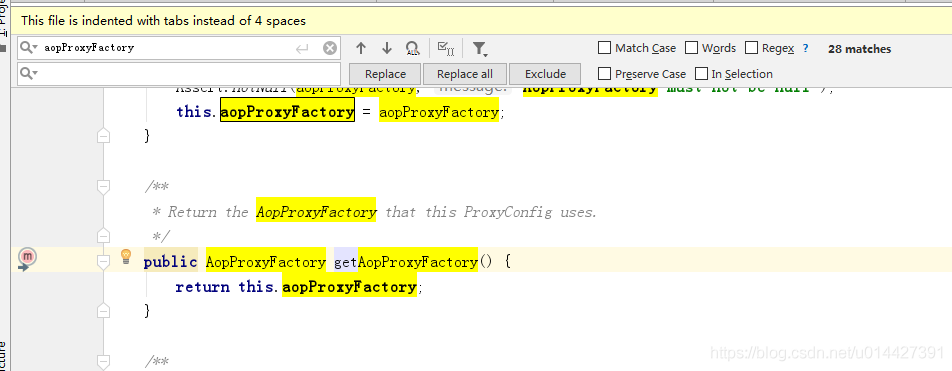
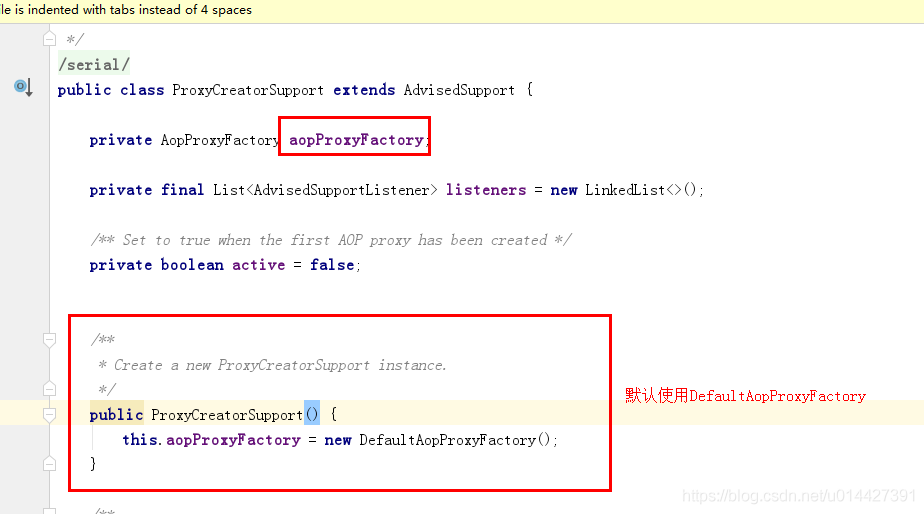
两个重要的代理对象:JdkDynamicAopProxy、ObjenesisCglibAopProxy
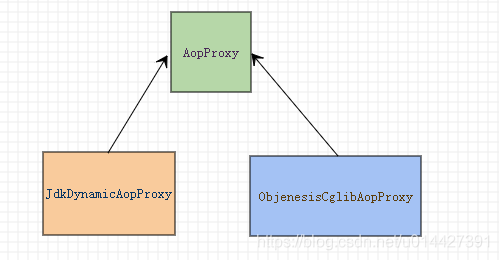
public class DefaultAopProxyFactory implements AopProxyFactory, Serializable {
@Override
public AopProxy createAopProxy(AdvisedSupport config) throws AopConfigException {
if (config.isOptimize() || config.isProxyTargetClass() || hasNoUserSuppliedProxyInterfaces(config)) {
Class<?> targetClass = config.getTargetClass();
if (targetClass == null) {
throw new AopConfigException("TargetSource cannot determine target class: " +
"Either an interface or a target is required for proxy creation.");
}
// 是接口(Interface)或者什么参数都不设置的情况使用JDK动态代理
if (targetClass.isInterface() || Proxy.isProxyClass(targetClass)) {
return new JdkDynamicAopProxy(config);
}
// 不是接口 proxyTargetClass为true的情况才使用CGLIB动态代理
return new ObjenesisCglibAopProxy(config);
}
else {
// JDK动态代理(默认)
return new JdkDynamicAopProxy(config);
}
}
/**
* Determine whether the supplied {@link AdvisedSupport} has only the
* {@link org.springframework.aop.SpringProxy} interface specified
* (or no proxy interfaces specified at all).
*/
private boolean hasNoUserSuppliedProxyInterfaces(AdvisedSupport config) {
Class<?>[] ifcs = config.getProxiedInterfaces();
return (ifcs.length == 0 || (ifcs.length == 1 && SpringProxy.class.isAssignableFrom(ifcs[0])));
}
}
作用情况:
- 是接口(Interface)或者什么参数都不设置的情况使用JDK动态代理
- 不是接口 proxyTargetClass为true的情况才使用CGLIB动态代理
8、创建AOP代理对象
往回看AopProxy是怎么创建代理对象的
/**
* Create a new proxy according to the settings in this factory.
* <p>Can be called repeatedly. Effect will vary if we've added
* or removed interfaces. Can add and remove interceptors.
* <p>Uses the given class loader (if necessary for proxy creation).
* @param classLoader the class loader to create the proxy with
* (or {@code null} for the low-level proxy facility's default)
* @return the proxy object
*/
public Object getProxy(@Nullable ClassLoader classLoader) {
// ⽤ProxyFactory创建AopProxy, 然后⽤AopProxy创建Proxy
return createAopProxy().getProxy(classLoader);
}
Spring AOP的两张重要代理:JDK动态代理、CGLIB动态代理

8.1、JDK动态代理
{@link org.springframework.aop.framework.JdkDynamicAopProxy#getProxy(java.lang.ClassLoader)}
@Override
public Object getProxy(@Nullable ClassLoader classLoader) {
if (logger.isDebugEnabled()) {
logger.debug("Creating JDK dynamic proxy: target source is " + this.advised.getTargetSource());
}
Class<?>[] proxiedInterfaces = AopProxyUtils.completeProxiedInterfaces(this.advised, true);
findDefinedEqualsAndHashCodeMethods(proxiedInterfaces);
// 获取代理实例 调用了JDK API进行newProxyInstance,创建实例,
// 参数:① classLoader,类加载实例 ② proxiedInterfaces,表示需要实现哪些接口
// ③ this,表示InvocationHandler,JdkDynamicAopProxy实现了InvocationHandler
return Proxy.newProxyInstance(classLoader, proxiedInterfaces, this);
}
8.2、CGLIB动态代理
{@link org.springframework.aop.framework.CglibAopProxy#getProxy(java.lang.ClassLoader)}
@Override
public Object getProxy(@Nullable ClassLoader classLoader) {
if (logger.isDebugEnabled()) {
logger.debug("Creating CGLIB proxy: target source is " + this.advised.getTargetSource());
}
try {
Class<?> rootClass = this.advised.getTargetClass();
Assert.state(rootClass != null, "Target class must be available for creating a CGLIB proxy");
Class<?> proxySuperClass = rootClass;
if (ClassUtils.isCglibProxyClass(rootClass)) {
proxySuperClass = rootClass.getSuperclass();
Class<?>[] additionalInterfaces = rootClass.getInterfaces();
for (Class<?> additionalInterface : additionalInterfaces) {
this.advised.addInterface(additionalInterface);
}
}
// Validate the class, writing log messages as necessary.
// 校验proxySuperClass,同时写日志
validateClassIfNecessary(proxySuperClass, classLoader);
// Configure CGLIB Enhancer...
// 配置CGLIB增强
Enhancer enhancer = createEnhancer();
if (classLoader != null) {
enhancer.setClassLoader(classLoader);
if (classLoader instanceof SmartClassLoader &&
((SmartClassLoader) classLoader).isClassReloadable(proxySuperClass)) {
enhancer.setUseCache(false);
}
}
enhancer.setSuperclass(proxySuperClass);
enhancer.setInterfaces(AopProxyUtils.completeProxiedInterfaces(this.advised));
enhancer.setNamingPolicy(SpringNamingPolicy.INSTANCE);
enhancer.setStrategy(new ClassLoaderAwareUndeclaredThrowableStrategy(classLoader));
Callback[] callbacks = getCallbacks(rootClass);
Class<?>[] types = new Class<?>[callbacks.length];
for (int x = 0; x < types.length; x++) {
types[x] = callbacks[x].getClass();
}
// fixedInterceptorMap only populated at this point, after getCallbacks call above
enhancer.setCallbackFilter(new ProxyCallbackFilter(
this.advised.getConfigurationOnlyCopy(), this.fixedInterceptorMap, this.fixedInterceptorOffset));
enhancer.setCallbackTypes(types);
// Generate the proxy class and create a proxy instance.
// ⽣成代理类,并且创建⼀个代理类的实例
return createProxyClassAndInstance(enhancer, callbacks);
}
catch (CodeGenerationException | IllegalArgumentException ex) {
throw new AopConfigException("Could not generate CGLIB subclass of " + this.advised.getTargetClass() +
": Common causes of this problem include using a final class or a non-visible class",
ex);
}
catch (Throwable ex) {
// TargetSource.getTarget() failed
throw new AopConfigException("Unexpected AOP exception", ex);
}
}
本文的代码例子可以在github找到下载链接:链接,SpringFramework代码中文注释,可以在我的github找到下载链接:链接
附录参考
优质博客参考:
- https://www.baeldung.com/spring-aop
- https://www.baeldung.com/spring-performance-logging
- https://www.javadoop.com/post/spring-aop-intro
本文同步分享在 博客“smileNicky”(CSDN)。
如有侵权,请联系 support@oschina.cn 删除。
本文参与“OSC源创计划”,欢迎正在阅读的你也加入,一起分享。





